Get free scan and check if your device is infected.
Remove it nowTo use full-featured product, you have to purchase a license for Combo Cleaner. Seven days free trial available. Combo Cleaner is owned and operated by RCS LT, the parent company of PCRisk.com.
What kind of malware is njRat?
The njRat program is categorized as a Remote Access Trojan (RAT). It usually installs without victims' knowledge, stealthily runs in the background (also without victims' knowledge), and collects various sensitive data. Cyber criminals use a number of methods to trick people into downloading and installing programs of this type.
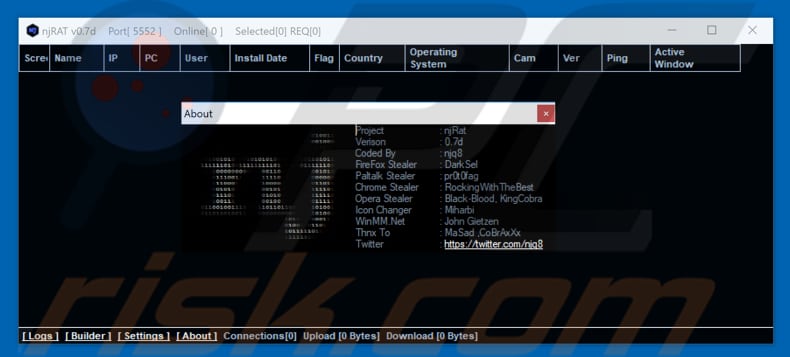
More about njRat
Cyber criminals use the njRat trojan-type program to gather system information, steal various usernames and passwords, and other personal, sensitive details. Additionally, it can be used to download and install malicious software. Generally, these programs send all collected data to remote servers that are controlled by cyber criminals.
Stolen/recorded data might be used for blackmail purposes or to generate revenue in other ways. By having access to various personal accounts, cyber criminals can cause privacy problems or even financial loss for the victims.
If used to download malicious programs, njRat might download ransomware-type viruses that are often used to block access to files stored on computers unless ransoms are paid. If there is any reason to believe that njRat is installed on your system, remove it immediately, otherwise, it can lead to various problems with data/financial loss and additional computer infections.
| Name | njRat remote access tool |
| Threat Type | Trojan, Password stealing virus, Banking malware, Spyware |
| Detection Names | Avast (MSIL:Agent-DRD [Trj]), BitDefender (Generic.MSIL.Bladabindi.47E8D306), ESET-NOD32 (A Variant Of MSIL/Bladabindi.AS), Kaspersky (HEUR:Trojan.Win32.Generic), Full List (VirusTotal) |
| Malicious Process Name(s) | t1uT3wb0.exe (the process name may vary). |
| Symptoms | Trojans are designed to stealthily infiltrate victim's computer and remain silent thus no particular symptoms are clearly visible on an infected machine. |
| Distribution methods | Infected email attachments, malicious online advertisements, social engineering, software cracks. |
| Damage | Stolen banking information, passwords, identity theft, victim's computer added to a botnet. |
| Malware Removal (Windows) |
To eliminate possible malware infections, scan your computer with legitimate antivirus software. Our security researchers recommend using Combo Cleaner. Download Combo CleanerTo use full-featured product, you have to purchase a license for Combo Cleaner. 7 days free trial available. Combo Cleaner is owned and operated by RCS LT, the parent company of PCRisk.com. |
Similarities with other RATs
njRat is similar to other tools of this type such as ExileRat, Nymeria, Remcos, NanoCore, and RMS. They might be distributed by different cyber criminals, however, the consequences of having these programs installed are serious problems.
If installed, njRat runs a process in Task Manager (screenshot below) called "t1uT3wb0.exe". Suspicious processes running in Task Manager are usually malicious programs.
How did njRat infiltrate my computer?
Cyber criminals often distribute malicious programs through emails (spam campaigns) that contain attached files. These are usually MS Office documents, JavaScript files, PDF documents, JavaScript or executable files, archives such as ZIP, RAR, and so on. Once opened, they download and install a specific computer infection.
They are also proliferated using dubious software download sources such as Peer-to-Peer networks, unofficial websites, third party downloaders, and so on. Malware might be disguised as a harmless program, however, once downloaded and opened (executed), it causes installation of viruses.
Furthermore, software 'cracking' tools and fake software updaters can be used to proliferate computer infections. Tools that are used to activate paid software free of charge often download and install malicious programs.
Unofficial updaters often exploit bugs/flaws of installed software that is out of date. Trojans also distribute viruses - once installed, these programs proliferate other computer infections.
How to avoid installation of malware?
If an email is received from an unknown or suspicious address, do not open attached files or included website links. Software should not be downloaded from unofficial websites, using third party downloaders, Peer-to-Peer networks, or other similar sources. The safest way to download is using official websites and direct links.
The same applies to software updates: installed programs should be updated using implemented functions or tools provided by official software developers (not third party tools/fake updaters). Software 'cracking' tools are illegal and often cause computer infections.
Therefore, they should never be trusted or used. To prevent computer infections, have a reputable anti-spyware or anti-virus suite installed and keep it enabled. If you believe that your computer is already infected, we recommend running a scan with Combo Cleaner Antivirus for Windows to automatically eliminate infiltrated malware.
Appearance of njRat tool (GIF):
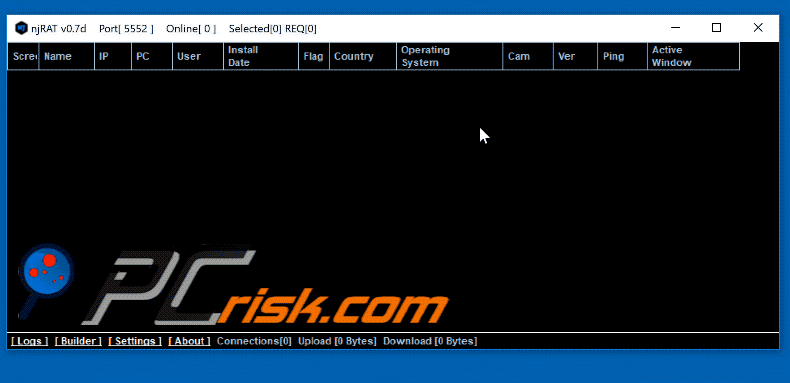
Screenshot of a malicious njRat process running in Task Manager as "t1uT3wb0.exe":
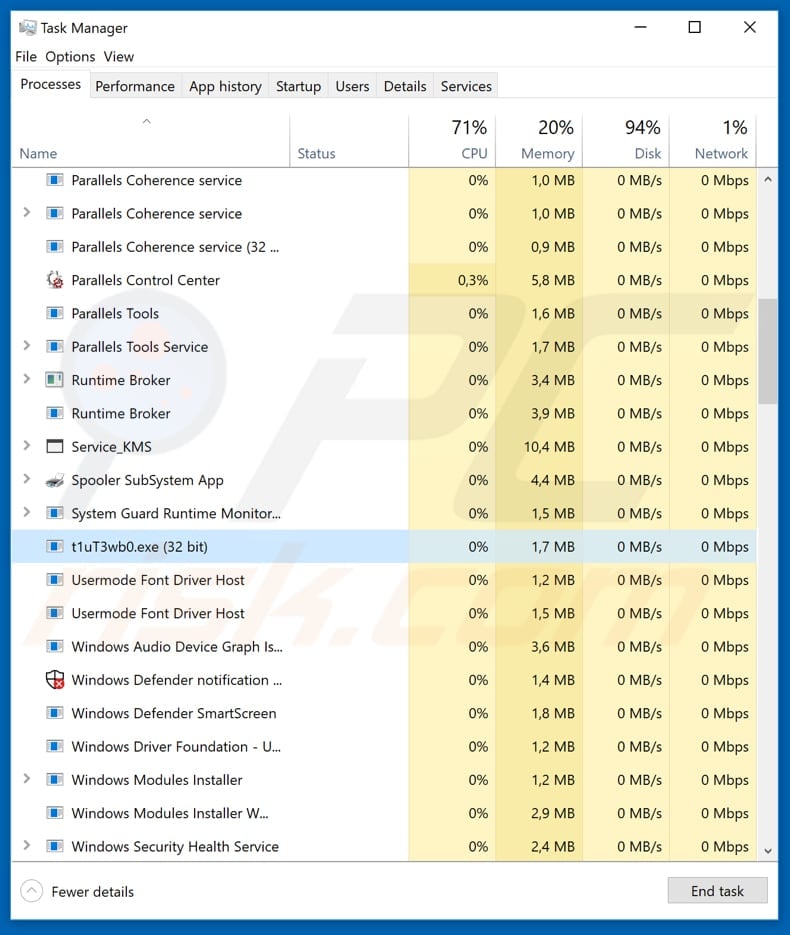
Update March 6, 2020 - Cyber criminals have recently released a new variant of njRat malware which is called "njRat Lime Edition". The list of its features includes:
| Anti Vmware, Sandboxie .. etc | Malware Killer | Socket Key Changer |
| Assembly And Icon Changer | Message Box | Startup using *.URL |
| Bypass UAC | Monitor OFF or ON | Task Manager Disable or Enable |
| CMD enable or disable [Admin] | Mouse reverse or normal | Taskbar show or hide |
| Chrome cookies remover | NO-IP Updater | Text To Speech |
| Clean My PC | Obfuscation | Torrent Seeder |
| Clipboard copy or clear | Persistence | USB Spread |
| Delete EventsViewer [Admin] | Plugin Compiler | Updated GeoIP.dat |
| Downloader | Reconnect Timeout | Updated Passwords Recovery |
| Flooder | Show Anti-Virus Software | Visible Client |
| Hide | Shutdown Restart PC | Visit webpage visible or hidden |
| MPress | Sleep |
Detection names of njRat Lime Edition in VirusTotal:
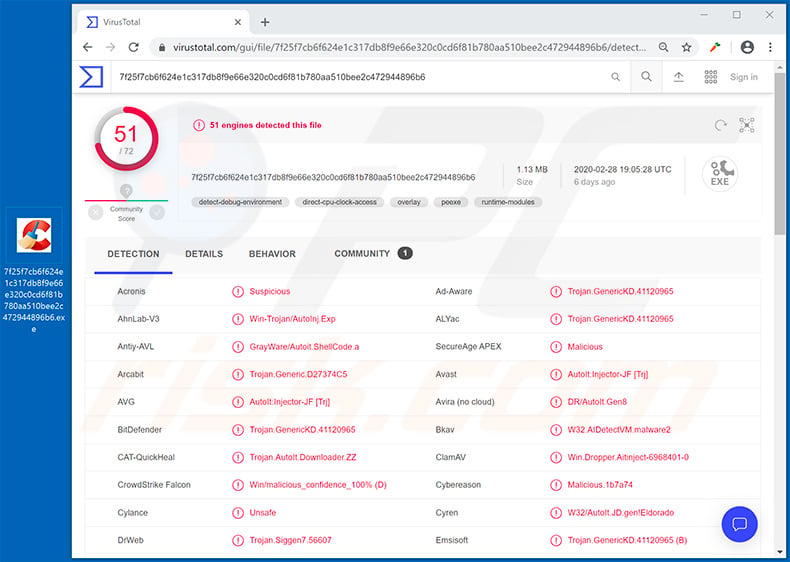
Screenshot of a spam email spreading njRat malware:
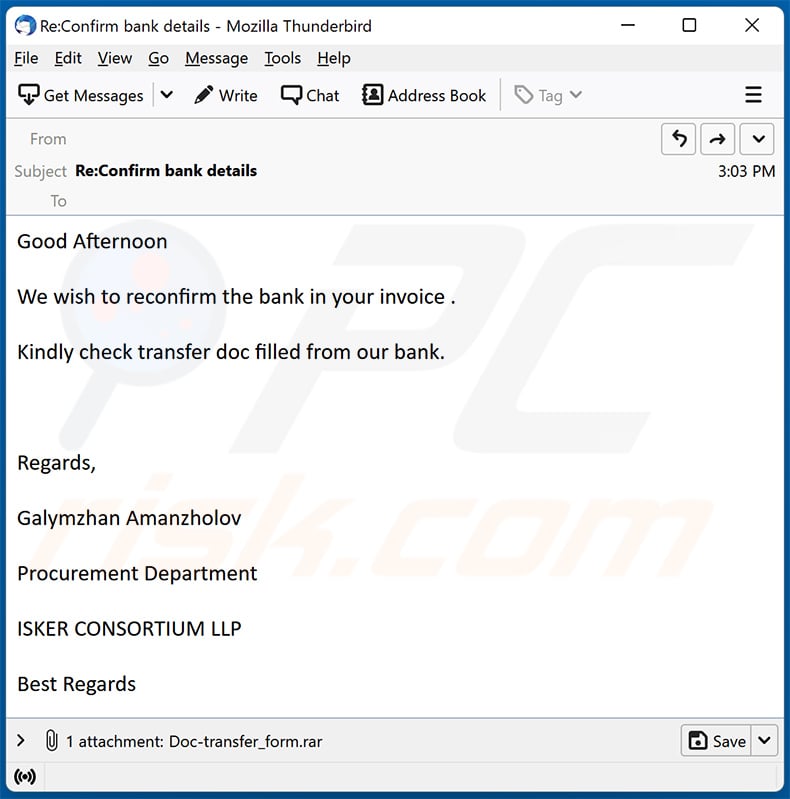
Text presented within:
Subject: Re:Confirm bank details
Good AfternoonWe wish to reconfirm the bank in your invoice .
Kindly check transfer doc filled from our bank.
Regards,
Galymzhan Amanzholov
Procurement Department
ISKER CONSORTIUM LLP
Best Regards
Instant automatic malware removal:
Manual threat removal might be a lengthy and complicated process that requires advanced IT skills. Combo Cleaner is a professional automatic malware removal tool that is recommended to get rid of malware. Download it by clicking the button below:
DOWNLOAD Combo CleanerBy downloading any software listed on this website you agree to our Privacy Policy and Terms of Use. To use full-featured product, you have to purchase a license for Combo Cleaner. 7 days free trial available. Combo Cleaner is owned and operated by RCS LT, the parent company of PCRisk.com.
Quick menu:
How to remove malware manually?
Manual malware removal is a complicated task - usually it is best to allow antivirus or anti-malware programs to do this automatically. To remove this malware we recommend using Combo Cleaner Antivirus for Windows.
If you wish to remove malware manually, the first step is to identify the name of the malware that you are trying to remove. Here is an example of a suspicious program running on a user's computer:

If you checked the list of programs running on your computer, for example, using task manager, and identified a program that looks suspicious, you should continue with these steps:
 Download a program called Autoruns. This program shows auto-start applications, Registry, and file system locations:
Download a program called Autoruns. This program shows auto-start applications, Registry, and file system locations:

 Restart your computer into Safe Mode:
Restart your computer into Safe Mode:
Windows XP and Windows 7 users: Start your computer in Safe Mode. Click Start, click Shut Down, click Restart, click OK. During your computer start process, press the F8 key on your keyboard multiple times until you see the Windows Advanced Option menu, and then select Safe Mode with Networking from the list.

Video showing how to start Windows 7 in "Safe Mode with Networking":
Windows 8 users: Start Windows 8 is Safe Mode with Networking - Go to Windows 8 Start Screen, type Advanced, in the search results select Settings. Click Advanced startup options, in the opened "General PC Settings" window, select Advanced startup.
Click the "Restart now" button. Your computer will now restart into the "Advanced Startup options menu". Click the "Troubleshoot" button, and then click the "Advanced options" button. In the advanced option screen, click "Startup settings".
Click the "Restart" button. Your PC will restart into the Startup Settings screen. Press F5 to boot in Safe Mode with Networking.

Video showing how to start Windows 8 in "Safe Mode with Networking":
Windows 10 users: Click the Windows logo and select the Power icon. In the opened menu click "Restart" while holding "Shift" button on your keyboard. In the "choose an option" window click on the "Troubleshoot", next select "Advanced options".
In the advanced options menu select "Startup Settings" and click on the "Restart" button. In the following window you should click the "F5" button on your keyboard. This will restart your operating system in safe mode with networking.

Video showing how to start Windows 10 in "Safe Mode with Networking":
 Extract the downloaded archive and run the Autoruns.exe file.
Extract the downloaded archive and run the Autoruns.exe file.

 In the Autoruns application, click "Options" at the top and uncheck "Hide Empty Locations" and "Hide Windows Entries" options. After this procedure, click the "Refresh" icon.
In the Autoruns application, click "Options" at the top and uncheck "Hide Empty Locations" and "Hide Windows Entries" options. After this procedure, click the "Refresh" icon.

 Check the list provided by the Autoruns application and locate the malware file that you want to eliminate.
Check the list provided by the Autoruns application and locate the malware file that you want to eliminate.
You should write down its full path and name. Note that some malware hides process names under legitimate Windows process names. At this stage, it is very important to avoid removing system files. After you locate the suspicious program you wish to remove, right click your mouse over its name and choose "Delete".

After removing the malware through the Autoruns application (this ensures that the malware will not run automatically on the next system startup), you should search for the malware name on your computer. Be sure to enable hidden files and folders before proceeding. If you find the filename of the malware, be sure to remove it.

Reboot your computer in normal mode. Following these steps should remove any malware from your computer. Note that manual threat removal requires advanced computer skills. If you do not have these skills, leave malware removal to antivirus and anti-malware programs.
These steps might not work with advanced malware infections. As always it is best to prevent infection than try to remove malware later. To keep your computer safe, install the latest operating system updates and use antivirus software. To be sure your computer is free of malware infections, we recommend scanning it with Combo Cleaner Antivirus for Windows.
Frequently Asked Questions (FAQ)
My computer is infected with njRat malware, should I format my storage device to get rid of it?
No, malware like njRat can be removed without formatting the storage device. Our malware removal guide is provided above.
What are the biggest issues that malware can cause?
Data encryption, identity theft, monetary loss, loss of access to online accounts (e.g., email, social media, banking accounts), etc.
What is the purpose of njRat malware?
It is a Remote Access Trojan that allows threat actors to steal sensitive information (e.g., passwords, credit card details) and distribute other malware. A new version of the njRat has additional features (the list of features available in that version is provided in our article).
How did a malware infiltrate my computer?
It is known that cybercriminals distribute njRat via email. They send emails containing malicious attachments (e.g., RAR files containing malicious files). Malware infiltrates the system after the execution of a malicious file. In certain cases, malware infects computers after performing additional steps (e.g., enabling macros commands in malicious documents).
Will Combo Cleaner protect me from malware?
Yes, Combo Cleaner can detect and remove almost all known malware from computers. High-end malware usually hides deep in the operating system. Thus, it cannot be removed without running a full scan.
Share:

Tomas Meskauskas
Expert security researcher, professional malware analyst
I am passionate about computer security and technology. I have an experience of over 10 years working in various companies related to computer technical issue solving and Internet security. I have been working as an author and editor for pcrisk.com since 2010. Follow me on Twitter and LinkedIn to stay informed about the latest online security threats.
PCrisk security portal is brought by a company RCS LT.
Joined forces of security researchers help educate computer users about the latest online security threats. More information about the company RCS LT.
Our malware removal guides are free. However, if you want to support us you can send us a donation.
DonatePCrisk security portal is brought by a company RCS LT.
Joined forces of security researchers help educate computer users about the latest online security threats. More information about the company RCS LT.
Our malware removal guides are free. However, if you want to support us you can send us a donation.
Donate
▼ Show Discussion